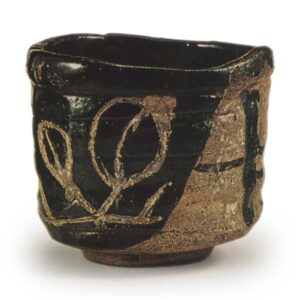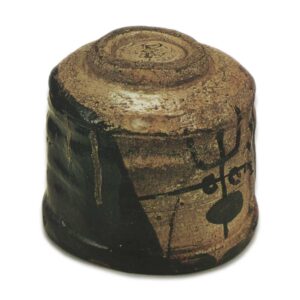

Collection: Tokugawa Art Museum
Height: 8.6 – 9.5 cm
Diameter: 9.7 – 10.0 cm
Outside diameter of foot ring: 5.5 cm
Height of foot ring: 0.9 cm
There are various types of Oribe ware, including Ao-Oribe, Narumi-Oribe, Aka-Oribe, Kuro-Oribe, Oribe-Kuro, E-Oribe, Nezumi-Oribe, Iga-Oribe and Karatsu-Oribe, but the type of Oribe ware with a black glaze and iron designs on the white areas, such as this cylindrical tea bowl, is called Kuro-Oribe. And the one with black glaze all over is called Oribe Kuro, and the name “Fuyugare” is not clear when and who gave it, but it is a masterpiece that represents the innovative and striking style of Oribe, and it is an Oribe that feels very much like Oribe. It is a masterpiece born in the lively Momoyama period.
The body is made of a rough grayish-white clay, and the inside and the outer half of the body are covered with jet-black glaze, while the other half and the bottom are covered with a cloudy white glaze. The black glaze on the outside has been scraped off to reveal an abstract pattern that is neither a large leaf nor a bud, and white glaze has been applied over this. The part of the body that has been coated with a milky white underglaze has an abstract iron painting pattern on the underside of the glaze that is also difficult to identify.
The shape is a deep brown bowl with thick fingerprints on the body, and the thick rim has several ridges that undulate and rise, giving it a characteristic Oribe-like variation.
There is a thick vertical line on the upper and lower parts of the body, and the foot is thick, but the shape is simple. The back of the foot is also coated with white powder, and only the tatami mat is exposed.
The firing seems to have been done in a reducing atmosphere, and when it was finished, it was pulled out of the kiln, and the marks of the long iron tweezers used to pull it out can be seen in the illustration, on the upper left-hand corner.
There is a mark of the letter ‘Q’ on the bottom, but this is not a kiln mark, and should be taken to be the signature of the tea master who made it. The reason for this is that tea bowls with the same ‘Q’ mark have been excavated from the Muta-dō area of Ōgaya, from Ōhira, and from the front kiln of the Inkyōzan area of Kujiri, and it is thought that the person who made this tea bowl visited these various kilns to make it.
The tea masters known to have traveled to Seto and Mino around the Tensho and Bunroku periods to make tea utensils include Shinbei, Kozo, Sho’i, Soho and Mo’emon, but it is said that the mark Q is Kozo’s mark. I have not investigated how reliable this tradition is, but in the Mino region there is a tradition that Q is Kozo’s mark.
The inner box is paulownia wood, and on the note written by Ryo Ryo Sai it says “Oribe tea bowl, winter withered (signature)”, and he was famous as the Oribe of the Okaya family in Nagoya, but the details of his lineage are not clear.



